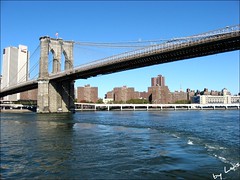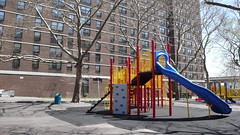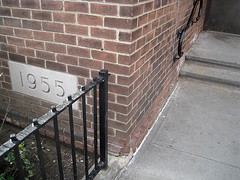Brooklyn Bridge

Construction on the bridge began in 1870; when
completed in 1883, it was half again as long as any
other suspension bridge in the world. At least 16
people died in its construction, including its
architect,
John Augustus Roebling, who contracted
tetanus after his foot was crushed by a ferry. His son
Washington Roebling, who inherited the project,
was stricken by compression sickness while working in
cassions, leaving Washington's wife
Emily Warren Roebling
to become the de facto chief engineer.

Soon after it was opened, on Memorial Day 1883, a panic on the bridge resulted in a dozen people being trampled to death.
Con artists actually have succeeded in repeatedly selling the Brooklyn Bridge to gullible victims.
The
Brooklyn Banks, located here under the bridge,
have been an internationally famous skateboard spot since
the 1980s.
|
1: George Washington moved to this address (sometime called No. 3) on April 23, 1789, when it was the site of a red brick mansion owned by Samuel Osgood, the nation's first postmaster general; on April 30, Washington was sworn in as the first president of the United States. He lived here until February 23, 1790, when the Osgoods wanted their house back. De Witt Clinton was living here in 1817 when he became governor of New York. The historic house was torn down in 1856 when the street was widened; a chair made out of timber salvaged from the ruin is now owned by the New-York Historical Society. Affixed to the bridge near the corner of Pearl and Dover streets is a plaque marking the approximate spot of the first president's first house. 5: John Hancock lived here in 1786, when he was president of the Continental Congress. William Marcy "Boss" Tweed, future leader of Tammany Hall, was born at this address on April 3, 1823. 7: In 1823, a three-story brick mansion here became the first home in New York City to be lit by gas. The owner, Samuel Leggett, was the president of the New York Gas Light Company. |





